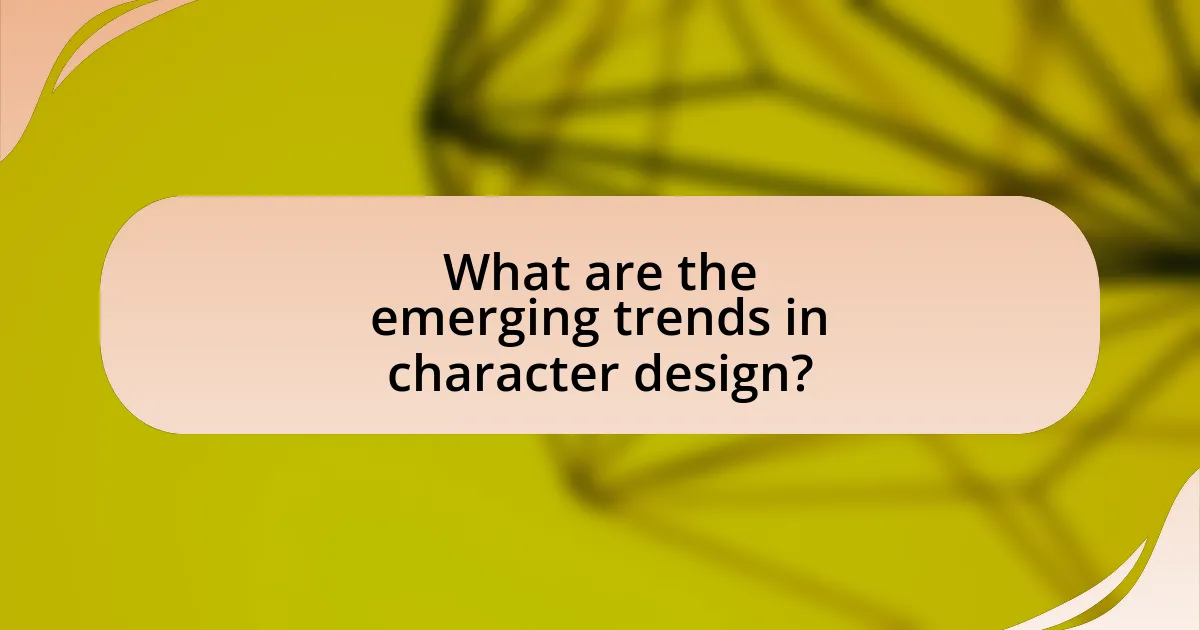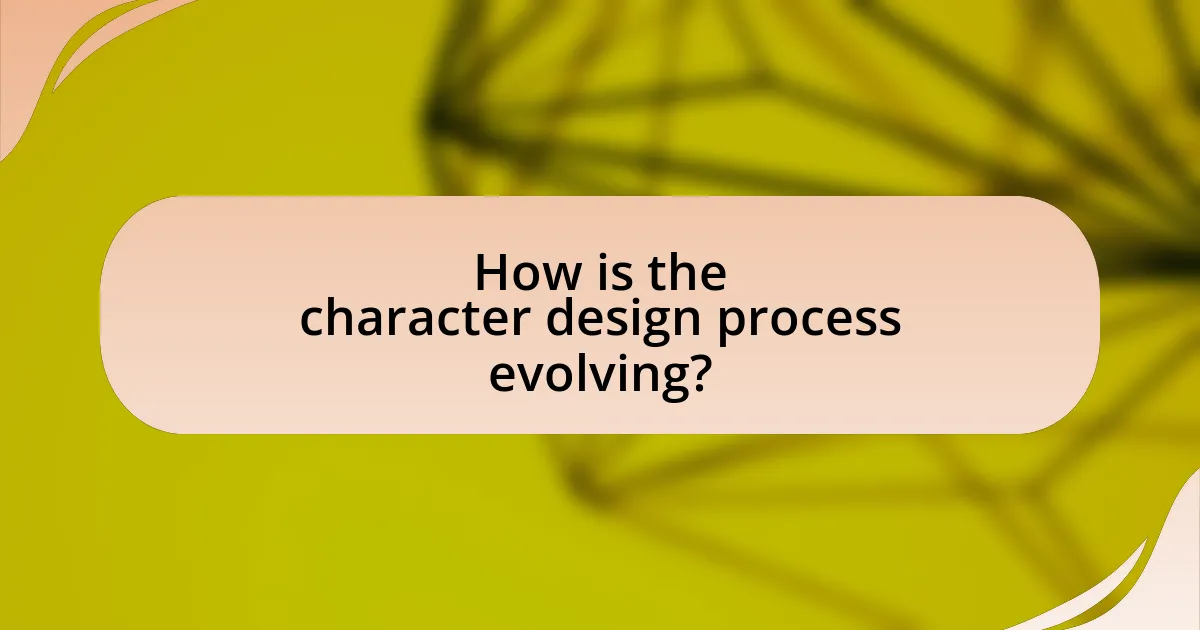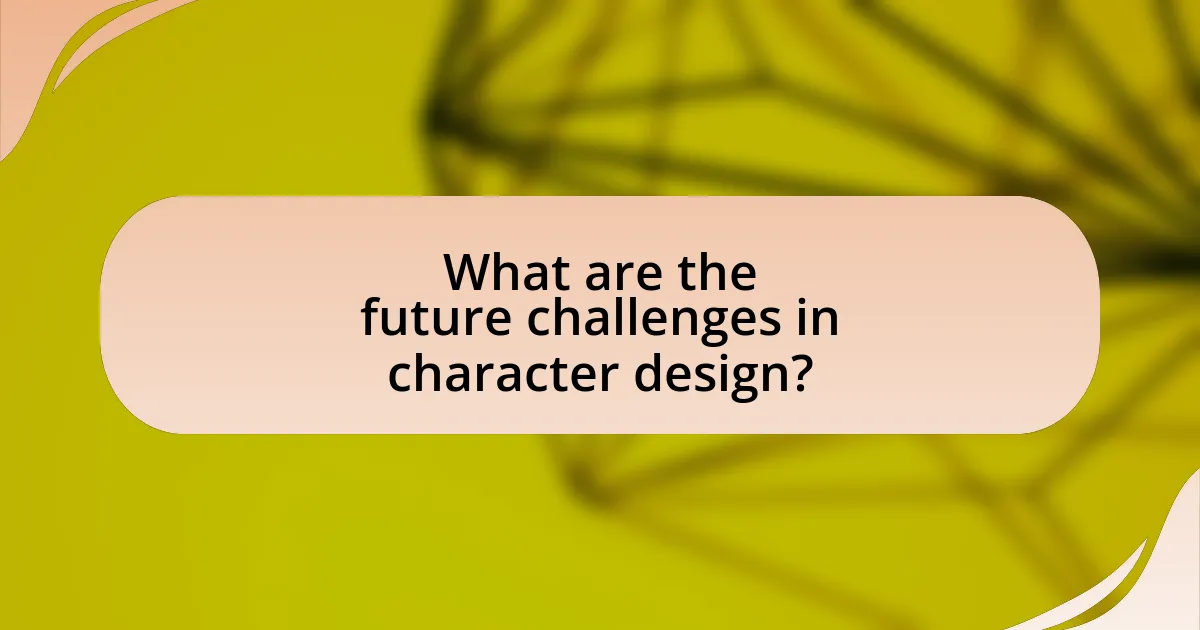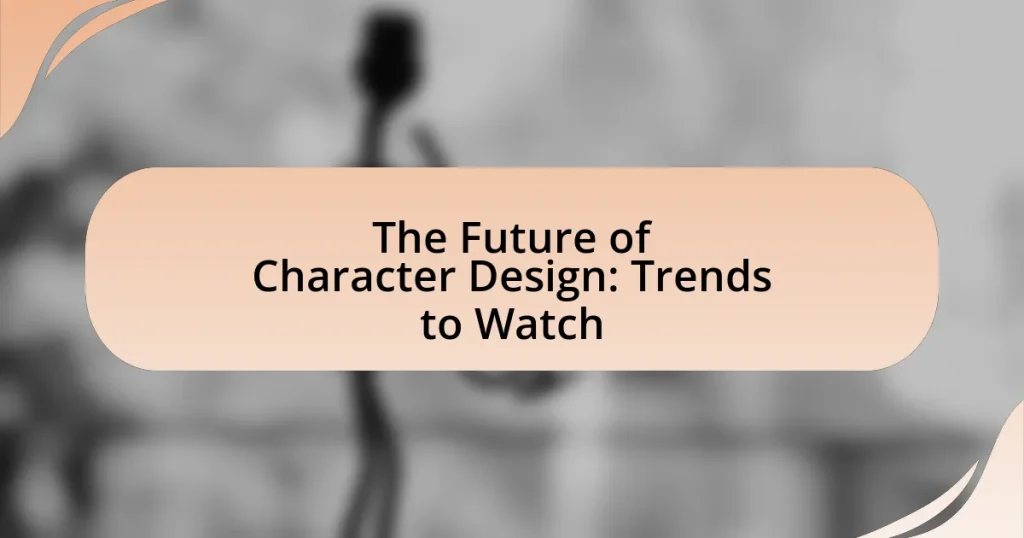The article focuses on the future of character design, highlighting emerging trends such as the integration of diverse cultural influences, advancements in augmented reality (AR) and virtual reality (VR), and a commitment to sustainability. It examines how technological advancements, particularly artificial intelligence, are reshaping the character creation process by enhancing efficiency and creativity. Additionally, the article discusses the impact of cultural shifts on character representation, the significance of collaborative and iterative design methodologies, and the essential tools and skills for future character designers. It concludes by addressing the challenges and best practices for eco-friendly character design, emphasizing the importance of diversity and audience engagement in modern storytelling.

What are the emerging trends in character design?
Emerging trends in character design include the integration of diverse cultural influences, the use of augmented reality (AR) and virtual reality (VR) technologies, and a focus on sustainability. Character designers are increasingly drawing inspiration from a wide range of cultures to create more inclusive and relatable characters, reflecting the global audience’s diversity. The adoption of AR and VR allows for interactive character experiences, enhancing user engagement and immersion. Additionally, there is a growing emphasis on sustainable design practices, where designers consider the environmental impact of their creations, opting for eco-friendly materials and processes. These trends are reshaping the character design landscape, making it more innovative and socially responsible.
How are technological advancements influencing character design?
Technological advancements are significantly influencing character design by enabling more detailed and dynamic representations through tools like 3D modeling software and artificial intelligence. These tools allow designers to create intricate textures, realistic animations, and complex character behaviors that were previously difficult to achieve. For instance, software such as Blender and Maya provides advanced rendering capabilities, allowing for lifelike characters in video games and films. Additionally, AI-driven algorithms can generate unique character designs and assist in the animation process, streamlining workflows and enhancing creativity. This evolution in technology not only improves the visual quality of characters but also expands the creative possibilities for designers, leading to more engaging and immersive experiences in various media.
What role does artificial intelligence play in character creation?
Artificial intelligence plays a significant role in character creation by enhancing the design process through automation and data analysis. AI algorithms can generate unique character designs based on predefined parameters, allowing creators to explore a wider range of possibilities quickly. For instance, tools like GANs (Generative Adversarial Networks) can produce diverse character visuals by learning from existing datasets, which streamlines the creative workflow. Additionally, AI can analyze audience preferences and trends, enabling designers to tailor characters that resonate with target demographics. This integration of AI not only increases efficiency but also fosters innovation in character design, as evidenced by the growing use of AI in video game and animation industries.
How are virtual reality and augmented reality shaping character design?
Virtual reality (VR) and augmented reality (AR) are significantly shaping character design by enabling immersive experiences and interactive elements that enhance user engagement. These technologies allow designers to create characters that can be experienced in three-dimensional spaces, providing a sense of presence and realism that traditional media cannot achieve. For instance, VR allows users to interact with characters in a fully realized environment, while AR overlays digital characters onto the real world, creating unique interactions. According to a report by the International Data Corporation, the global AR and VR market is expected to reach $198 billion by 2025, indicating a growing investment in these technologies that directly influences character design practices. This shift encourages designers to focus on adaptability and interactivity, leading to more dynamic and responsive character designs that can evolve based on user interactions.
What cultural shifts are impacting character design trends?
Cultural shifts such as increased diversity, the rise of social media, and a focus on mental health are significantly impacting character design trends. The demand for representation has led to more inclusive character designs that reflect various ethnicities, genders, and body types, as seen in popular media like animated films and video games. Additionally, social media platforms have accelerated the sharing of character designs, influencing trends through community feedback and viral content. The growing awareness of mental health has also prompted designers to create characters that embody emotional depth and relatability, aligning with contemporary societal values. These shifts are reshaping the landscape of character design, making it more reflective of a diverse and interconnected world.
How does diversity and representation affect character design?
Diversity and representation significantly enhance character design by fostering inclusivity and relatability in visual storytelling. When character designers incorporate diverse backgrounds, cultures, and identities, they create characters that resonate with a broader audience, reflecting the real-world diversity of society. Research indicates that diverse representation in media can lead to increased engagement and positive reception among viewers, as seen in the success of films like “Black Panther,” which showcased a predominantly Black cast and celebrated African culture, resulting in over $1.3 billion in global box office revenue. This demonstrates that thoughtful character design, rooted in diversity and representation, not only enriches narratives but also drives commercial success.
What are the implications of global storytelling on character design?
Global storytelling significantly influences character design by promoting diversity and cultural representation. As narratives increasingly draw from a variety of cultural backgrounds, character designers must create characters that reflect this diversity, ensuring authenticity and relatability. For instance, the rise of global media platforms has led to characters that embody traits, attire, and values from different cultures, enhancing audience engagement and acceptance. This shift is evident in animated films and video games, where characters are designed to resonate with a global audience, as seen in productions like Disney’s “Raya and the Last Dragon,” which showcases Southeast Asian culture. Such examples illustrate that global storytelling not only broadens the scope of character design but also necessitates a deeper understanding of cultural nuances to avoid stereotypes and foster inclusivity.

How is the character design process evolving?
The character design process is evolving through the integration of advanced technology, particularly artificial intelligence and 3D modeling software. These tools enable designers to create more complex and diverse characters with greater efficiency and detail. For instance, AI-driven design platforms can analyze existing character traits and suggest new designs based on popular trends, significantly speeding up the creative process. Additionally, the rise of virtual reality and augmented reality is pushing character designers to consider how characters will interact in immersive environments, leading to more dynamic and adaptable designs. This evolution reflects a broader trend in the industry towards more inclusive and representative character creation, as designers increasingly prioritize diversity in their work to resonate with global audiences.
What new methodologies are being adopted in character design?
New methodologies being adopted in character design include the use of artificial intelligence (AI) for generating character concepts and the integration of virtual reality (VR) for immersive design experiences. AI tools, such as generative adversarial networks (GANs), enable designers to create diverse character designs quickly by analyzing existing styles and generating new variations. Additionally, VR allows designers to visualize and interact with characters in a three-dimensional space, enhancing the creative process and enabling real-time adjustments. These methodologies reflect a shift towards technology-driven approaches in character design, facilitating innovation and efficiency in the creative workflow.
How does collaborative design enhance character development?
Collaborative design enhances character development by integrating diverse perspectives and expertise, leading to richer and more nuanced characters. When multiple creators contribute, they bring unique insights that can deepen character backstories, motivations, and relationships. For instance, a study by the University of Southern California found that collaborative storytelling in game design resulted in characters that resonated more with audiences due to the varied input from writers, artists, and designers. This collective approach not only fosters creativity but also ensures that characters are relatable and multidimensional, ultimately improving audience engagement and satisfaction.
What is the significance of iterative design in character creation?
Iterative design is significant in character creation because it allows for continuous refinement and improvement of character concepts based on feedback and testing. This process enables designers to explore multiple variations, assess audience reactions, and make informed adjustments, ultimately leading to more engaging and relatable characters. For instance, in the video game industry, iterative design has been shown to enhance player experience by incorporating player feedback into character development, as seen in successful franchises like “The Legend of Zelda,” where character designs evolved through player interactions and critiques. This approach not only fosters creativity but also ensures that the final character resonates well with the target audience, making iterative design a crucial element in modern character creation.
What tools and software are becoming essential for character designers?
Character designers are increasingly relying on tools and software such as Adobe Photoshop, Autodesk Maya, ZBrush, and Procreate. Adobe Photoshop is essential for 2D character design and concept art, while Autodesk Maya and ZBrush are critical for 3D modeling and sculpting, allowing for detailed character creation. Procreate has gained popularity among illustrators for its intuitive interface and powerful features on iPad, making it a go-to for digital sketching. The integration of these tools into the design workflow enhances efficiency and creativity, reflecting the industry’s shift towards digital platforms and advanced rendering techniques.
Which software is leading the market for character design?
Adobe Photoshop is leading the market for character design. It is widely used by professionals in the animation and gaming industries due to its extensive features for digital painting, illustration, and photo editing. According to a survey by the International Game Developers Association, over 70% of game developers reported using Adobe Photoshop as their primary tool for character design, highlighting its dominance in the field.
How do these tools improve the efficiency of the design process?
These tools improve the efficiency of the design process by automating repetitive tasks and enhancing collaboration among team members. Automation reduces the time spent on manual adjustments, allowing designers to focus on creativity and innovation. For instance, software that generates character models or textures can significantly speed up the initial design phase. Additionally, collaborative platforms enable real-time feedback and version control, which streamlines communication and minimizes errors. Research indicates that teams using collaborative design tools can reduce project timelines by up to 30%, demonstrating a clear impact on efficiency.

What are the future challenges in character design?
Future challenges in character design include the need for greater diversity and representation, the integration of advanced technology such as AI and VR, and the balancing of artistic creativity with audience expectations. As the industry evolves, designers must address the demand for characters that reflect a wide range of backgrounds and experiences, which is supported by studies showing that diverse representation can enhance audience engagement and relatability. Additionally, the rise of AI tools and virtual reality environments presents both opportunities and challenges, as designers must adapt to new workflows while maintaining the authenticity and emotional depth of characters. Finally, understanding and meeting audience expectations, which are increasingly shaped by social media and global trends, requires designers to be agile and responsive in their creative processes.
How will sustainability impact character design practices?
Sustainability will significantly influence character design practices by prioritizing eco-friendly materials and processes. Designers will increasingly adopt sustainable practices, such as using recycled or biodegradable materials, to reduce environmental impact. For instance, the animation industry has seen a shift towards digital tools that minimize waste, as evidenced by studios like Pixar implementing energy-efficient technologies in their production pipelines. This trend not only aligns with global sustainability goals but also appeals to environmentally conscious consumers, thereby enhancing brand loyalty and marketability.
What are the best practices for eco-friendly character design?
The best practices for eco-friendly character design include using sustainable materials, minimizing waste, and promoting environmental awareness through character narratives. Sustainable materials, such as recycled plastics or biodegradable substances, reduce the ecological footprint of character production. Minimizing waste can be achieved by optimizing design processes to limit excess materials and utilizing digital tools to create virtual prototypes. Additionally, incorporating themes of environmental stewardship in character stories can raise awareness and inspire audiences to adopt eco-friendly practices. These approaches not only contribute to sustainability but also resonate with consumers increasingly concerned about environmental issues.
How can designers balance creativity with sustainability?
Designers can balance creativity with sustainability by integrating eco-friendly materials and processes into their design practices. This approach allows for innovative designs that minimize environmental impact while still appealing to consumers. For instance, using biodegradable materials or recycled components can inspire unique aesthetics and functionality, demonstrating that sustainability can enhance creativity rather than hinder it. Research from the Ellen MacArthur Foundation indicates that sustainable design practices can lead to a 30% reduction in resource consumption, showcasing the potential for designers to create impactful work that aligns with environmental goals.
What skills will be essential for future character designers?
Essential skills for future character designers include proficiency in digital art tools, strong understanding of anatomy and movement, creativity in character development, and knowledge of storytelling techniques. Proficiency in digital art tools, such as Adobe Creative Suite and 3D modeling software, is crucial as the industry increasingly relies on technology for character creation. A strong understanding of anatomy and movement allows designers to create realistic and relatable characters, which is supported by the fact that characters with believable physicality enhance audience engagement. Creativity in character development is vital for producing unique and memorable designs, while knowledge of storytelling techniques ensures that characters resonate with narratives, as evidenced by the success of character-driven stories in films and games.
How can aspiring character designers prepare for future trends?
Aspiring character designers can prepare for future trends by actively researching emerging technologies and styles in the industry. Engaging with platforms like ArtStation and Behance allows designers to observe current popular aesthetics and techniques. Additionally, participating in online courses and workshops focused on digital art and 3D modeling can enhance their skill set, aligning with the industry’s shift towards more immersive and interactive character designs. According to a report by the International Game Developers Association, 70% of game developers are increasingly incorporating virtual reality and augmented reality elements into their projects, indicating a significant trend that character designers should be aware of. By staying informed and continuously developing their skills, aspiring designers can effectively adapt to the evolving landscape of character design.
What educational resources are available for developing necessary skills?
Online courses, workshops, and tutorials are key educational resources available for developing necessary skills in character design. Platforms like Coursera, Udemy, and Skillshare offer specialized courses that cover various aspects of character design, including anatomy, color theory, and digital illustration techniques. Additionally, industry-standard software tutorials, such as those for Adobe Creative Suite and Blender, provide practical skills essential for modern character design. According to a report by the International Game Developers Association, 70% of game developers emphasize the importance of continuous learning through such resources to stay competitive in the evolving field of character design.
What practical tips can enhance character design in the future?
To enhance character design in the future, designers should prioritize diversity and inclusivity in their character representations. This approach not only reflects a broader range of human experiences but also resonates with a global audience, as evidenced by studies showing that diverse characters lead to increased engagement and relatability in media. Additionally, incorporating advanced technology, such as AI-driven design tools, can streamline the creative process and allow for more innovative character features. Research indicates that tools leveraging machine learning can analyze audience preferences, enabling designers to create characters that better align with viewer expectations and trends.


